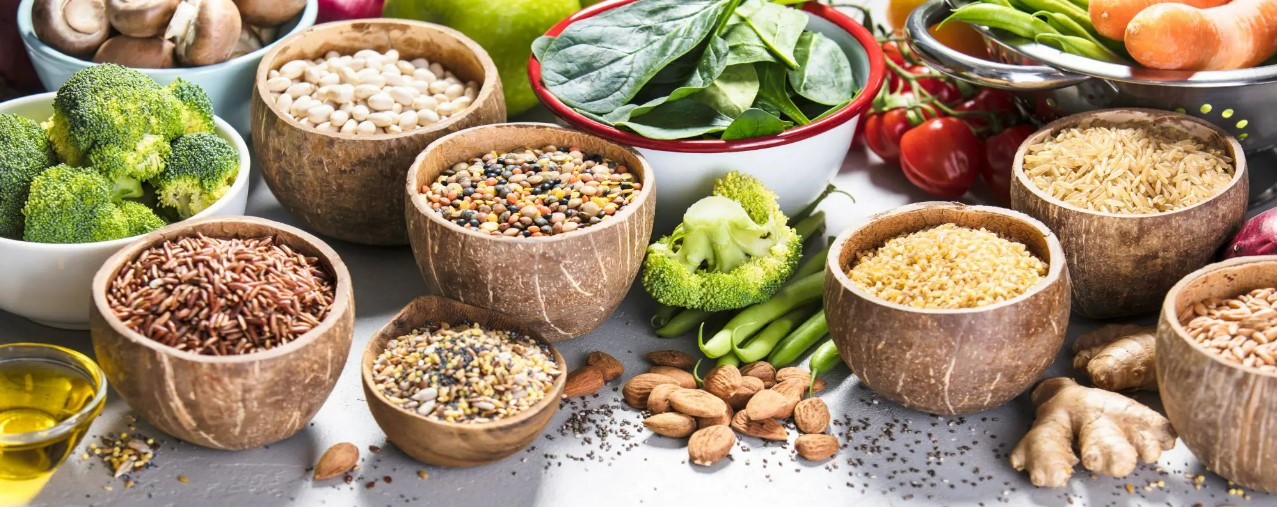Fibre types
Insoluble fibre in whole grain foods
Contrary to popular belief, eating cereal-based starchy foods every day does not make you fat, and it helps your digestive system to function properly. On condition that you favour whole grain or semi-wholegrain carbohydrates, which are sources of insoluble dietary fibre, side effects such as bloating disappear rapidly.
This type of fibre, called insoluble (IF) is made up of lignin and cellulose, molecules which are not broken down during digestion. They expand in water, which helps transit (bulking effect) and improve the sensation of satiety. They also have the ability to store fats hence their cholesterol-lowering properties.
Foods rich in insoluble fibre include: whole grain bread, cereal products, brown rice, wheat bran, wholemeal flour and not white flour,
Soluble dietary fibre
Fruits and vegetables, rhizomes such as potatoes, root vegetables (raw carrots, beetroot, turnips etc.), pulses, and algae are all rich in soluble dietary fibre.
These fibres (SF) include mucilages, pectins and partially digested gums. During the journey through the digestive system, the soluble fibre reacts with liquid and becomes a gel which is gentle for the intestines and regulates transit. They help maintain the microbiota thanks to their pre-biotic function.
They are a welcome source of nutrition for colon bacteria, including lactobacilli and bifidobacteria, which help to regenerate and repair the mucous membrane. They are also efficient allies used in intestinal transit regulation.
Which foods are the richest in fibre?
Overwhelmingly the fruits and vegetables!
- apples, plums, apricots, red fruit; dried fruit provides plenty of insoluble fibre, a real help for sluggish intestinal transit.
- spinach, artichokes, peas, all types of cabbage (green, white, red, cooked broccoli, cauliflower, Brussels sprouts, etc.), and old varieties of vegetables (Jerusalem artichokes, parsnips, long radishes, etc.) as well as seaweed.
The benefits of dietary fibre: what are they for?
Only plant-based foods provide fibre. They have significant benefits for digestion, blood sugar levels, satiety and carbohydrate metabolism.
Reducing the glycaemic index
Most foods contain carbohydrates. During digestion carbohydrates can cause an increase in blood sugar levels. The simpler the carbohydrate (known as fast), such as white sugar, the higher the blood sugar peak. A spike in blood sugar levels means rapid, large-scale secretion of insulin, but also an equally rapid fall in blood sugar levels. This series of biological reactions promotes reactionary hypoglycaemia.
The glycaemic index (GI) gives a measure of a food's insulin capacity. In other words, the ability of the nutrients in the food to stimulate insulin production. Which helps control blood sugar levels.
Fibre raises blood sugar levels only very moderately. Therefore, food containing sugar and fibre will have a lower glycaemic index than food without fibre. Various studies have reported their effects on carbohydrate metabolism.
|
Food
|
Glycemic index
|
|
White sugar (0 fibre)
|
100
|
|
Dried figs (fibres +)
|
40
|
|
Oilseed fruits (fibres +++)
|
15
|
Better fat absorption
Dietary fibre can help reduce the rate of LDL cholesterol, by limiting the fats absorbed by the intestine. They are a key factor in preventing cardiovascular disease1.
Regulating transit
Fibre absorbs 3 to 25 times its weight in water. Consequently, stool volume is increased and the journey through the intestines made easier. The end result is better regulated transit. Provided you stay sufficiently hydrated (1.5 litres a day).
Appetite regulation
A meal that is rich in fibre will give a feeling of satiety, whereas a meal low in fibre may never end... as satiety is harder to achieve.
*ANSES - the French national food safety agency
1 Wendy J Dahl all., Health Benefits of Fiber Fermentation, 2017
